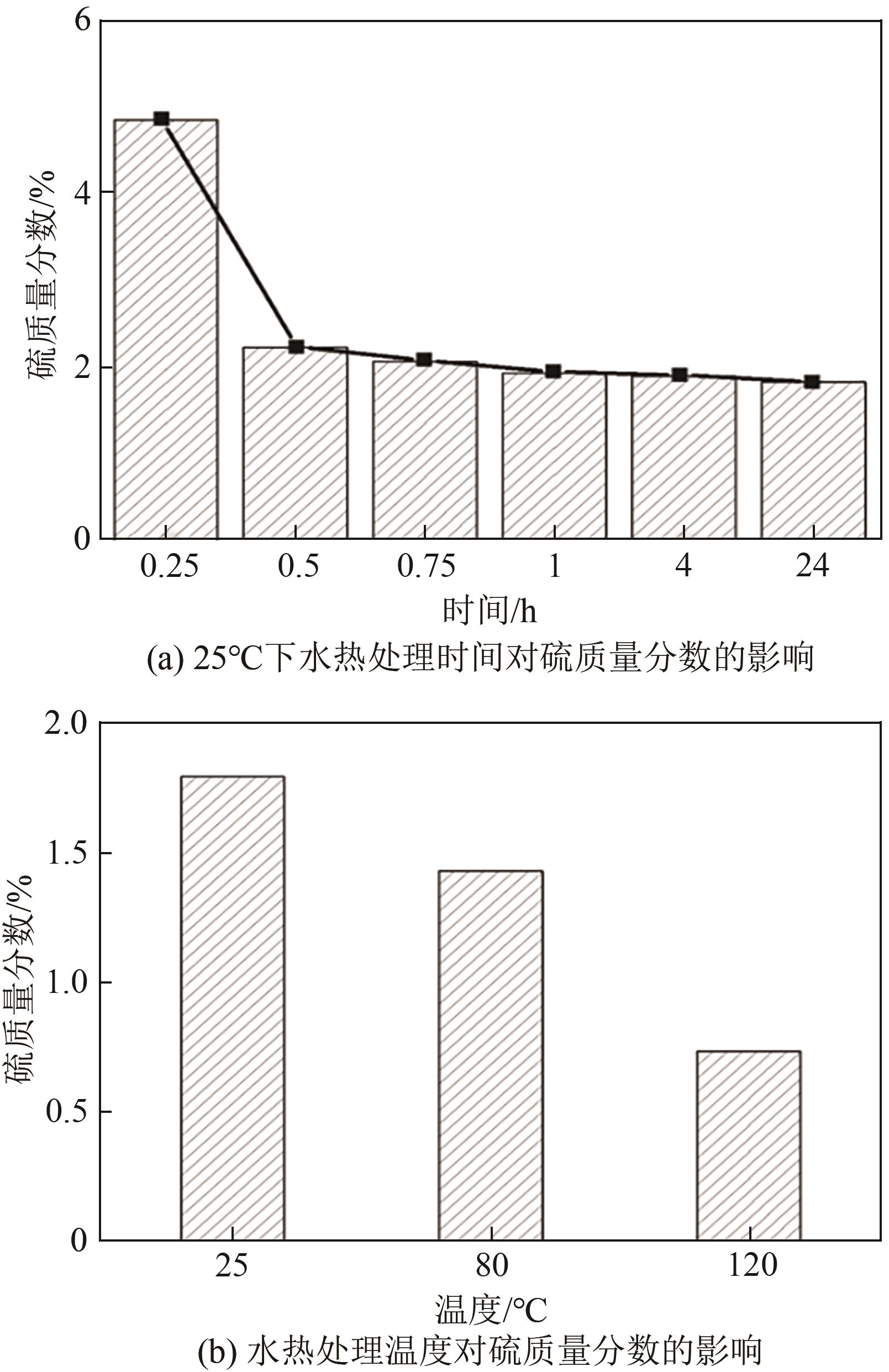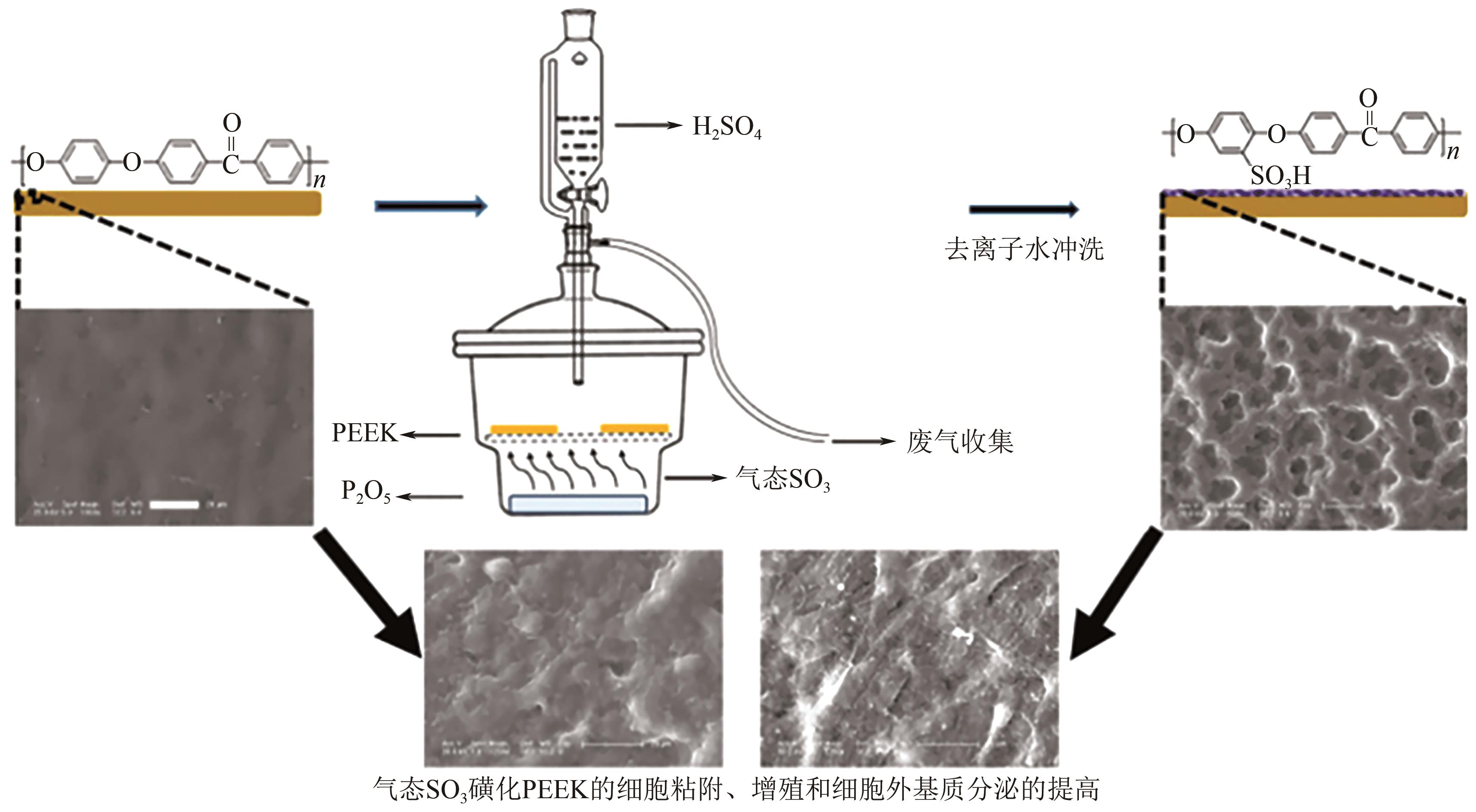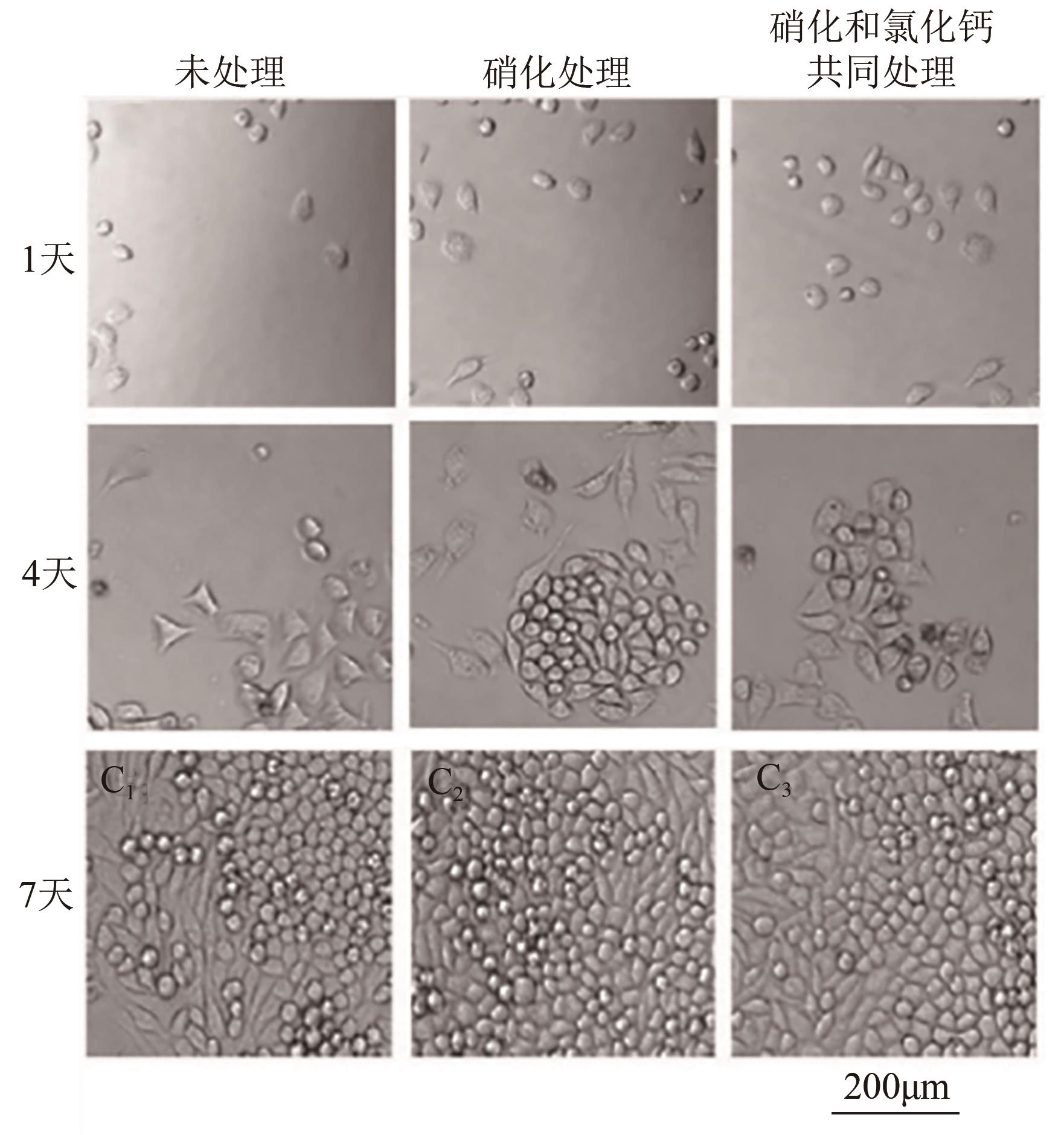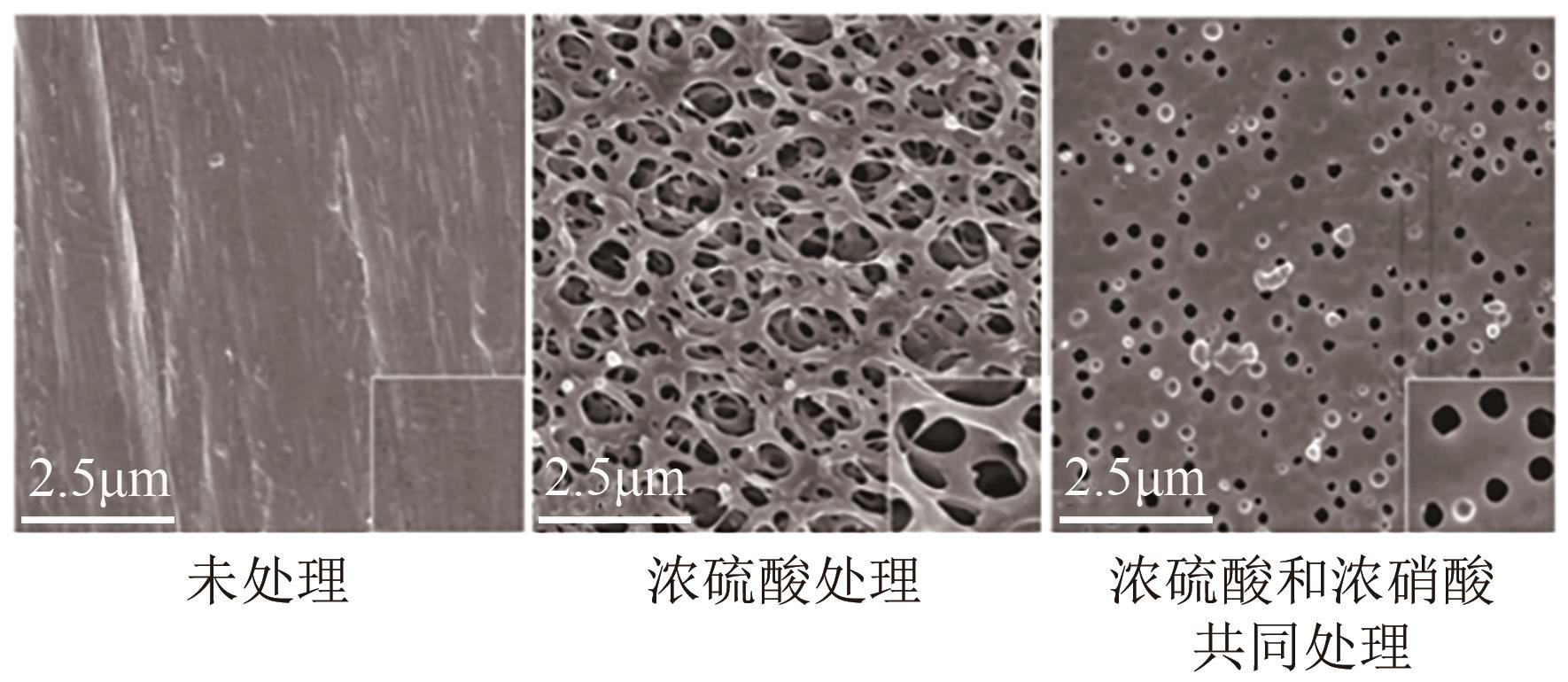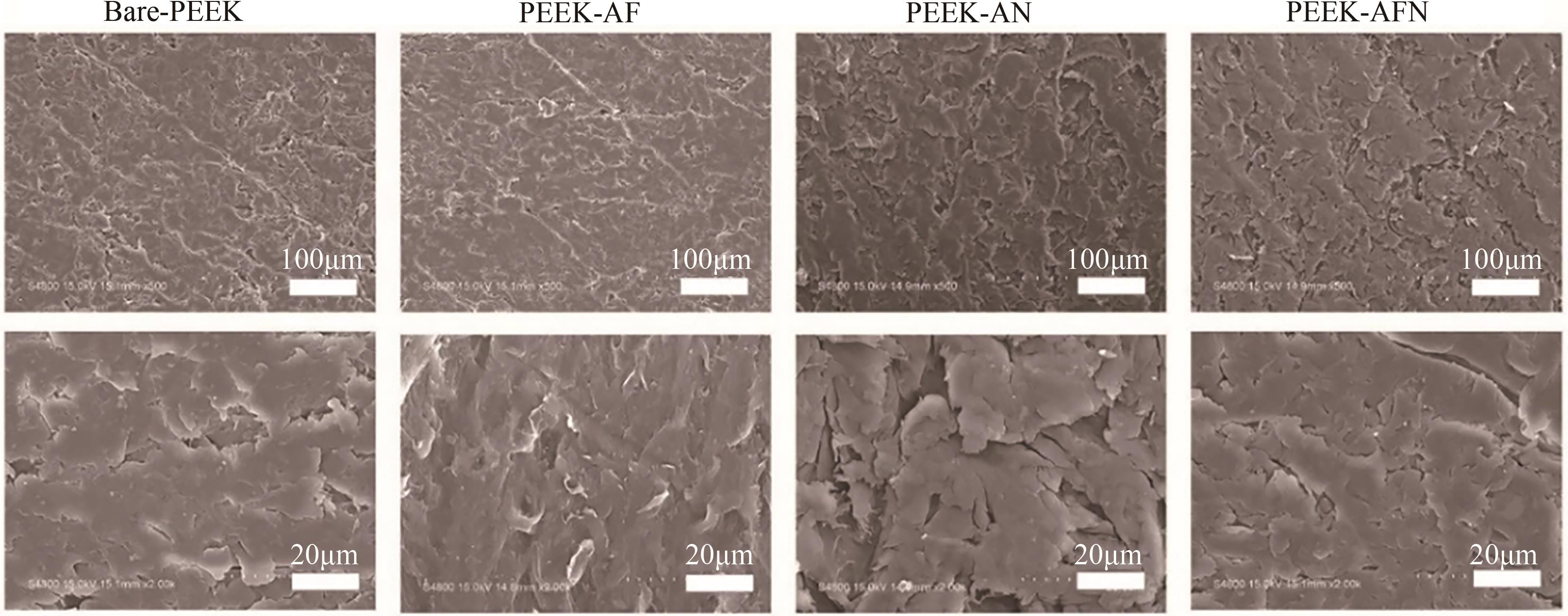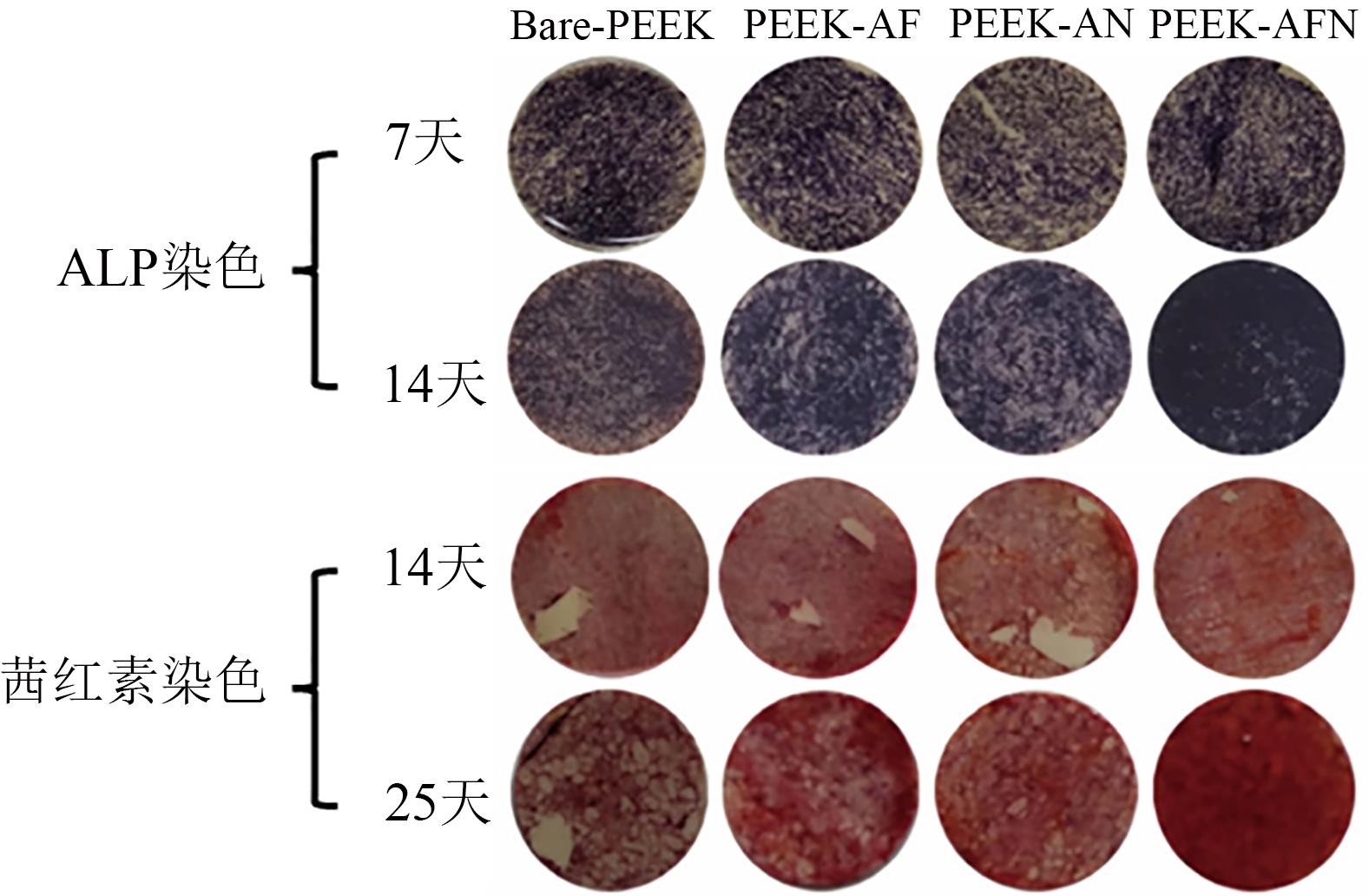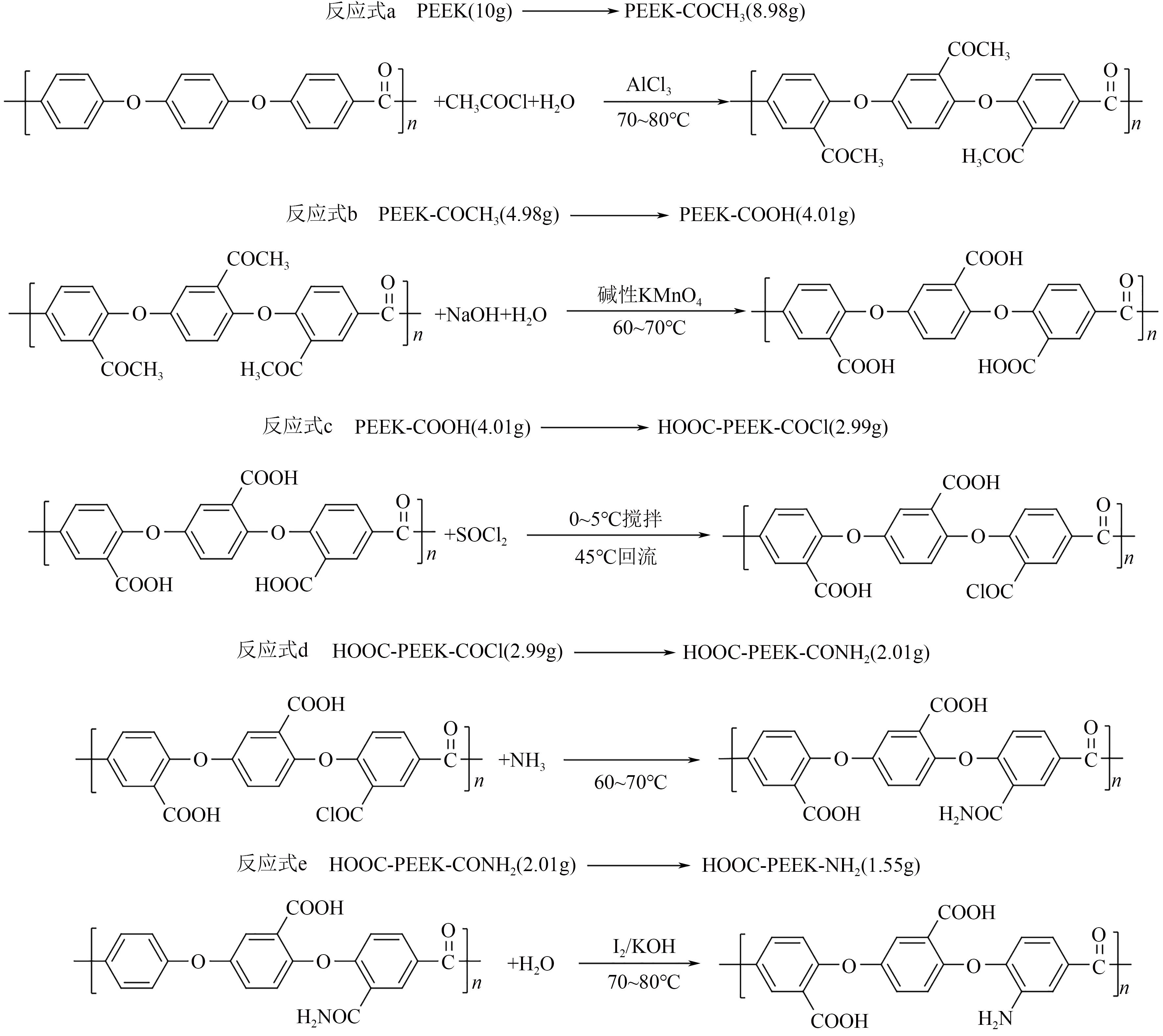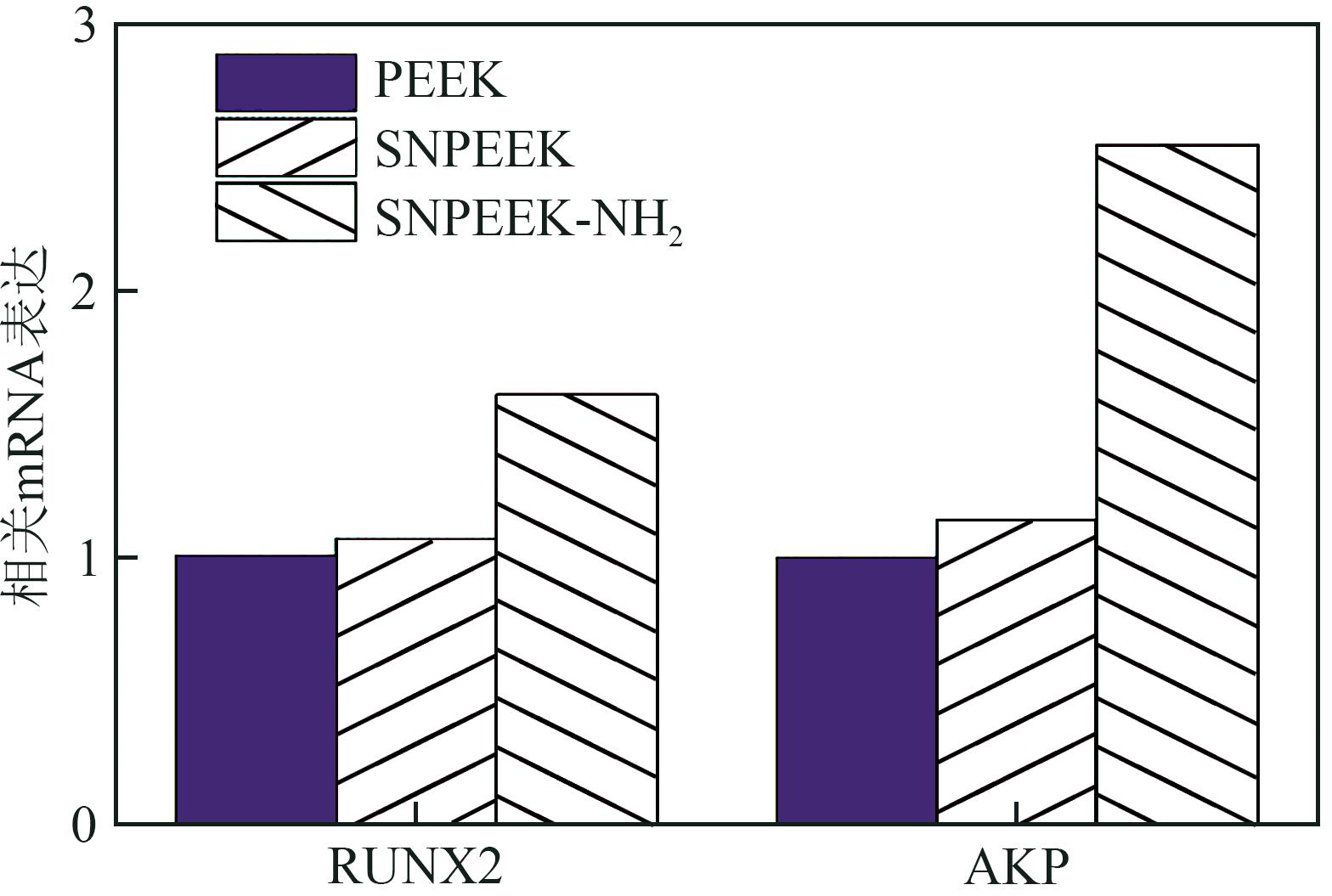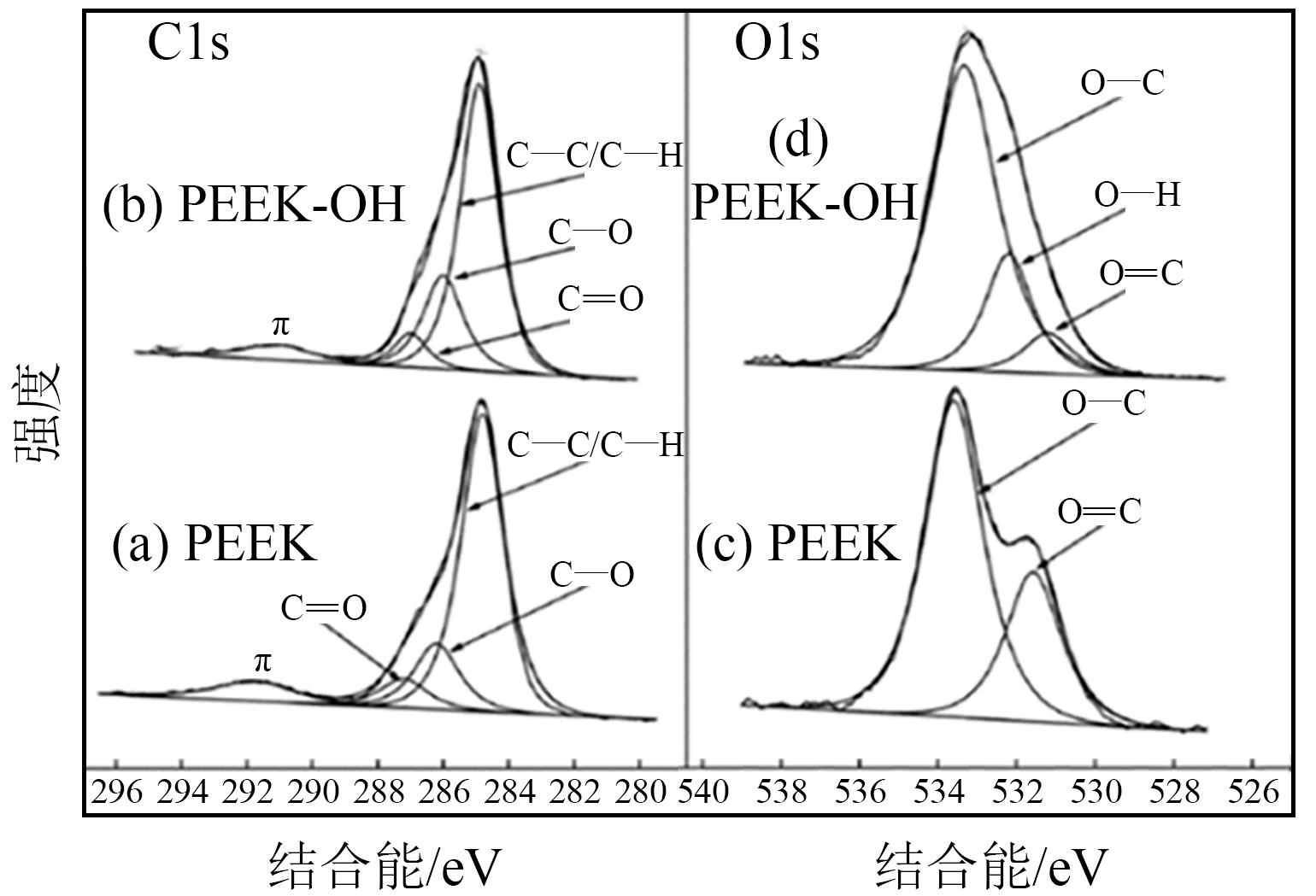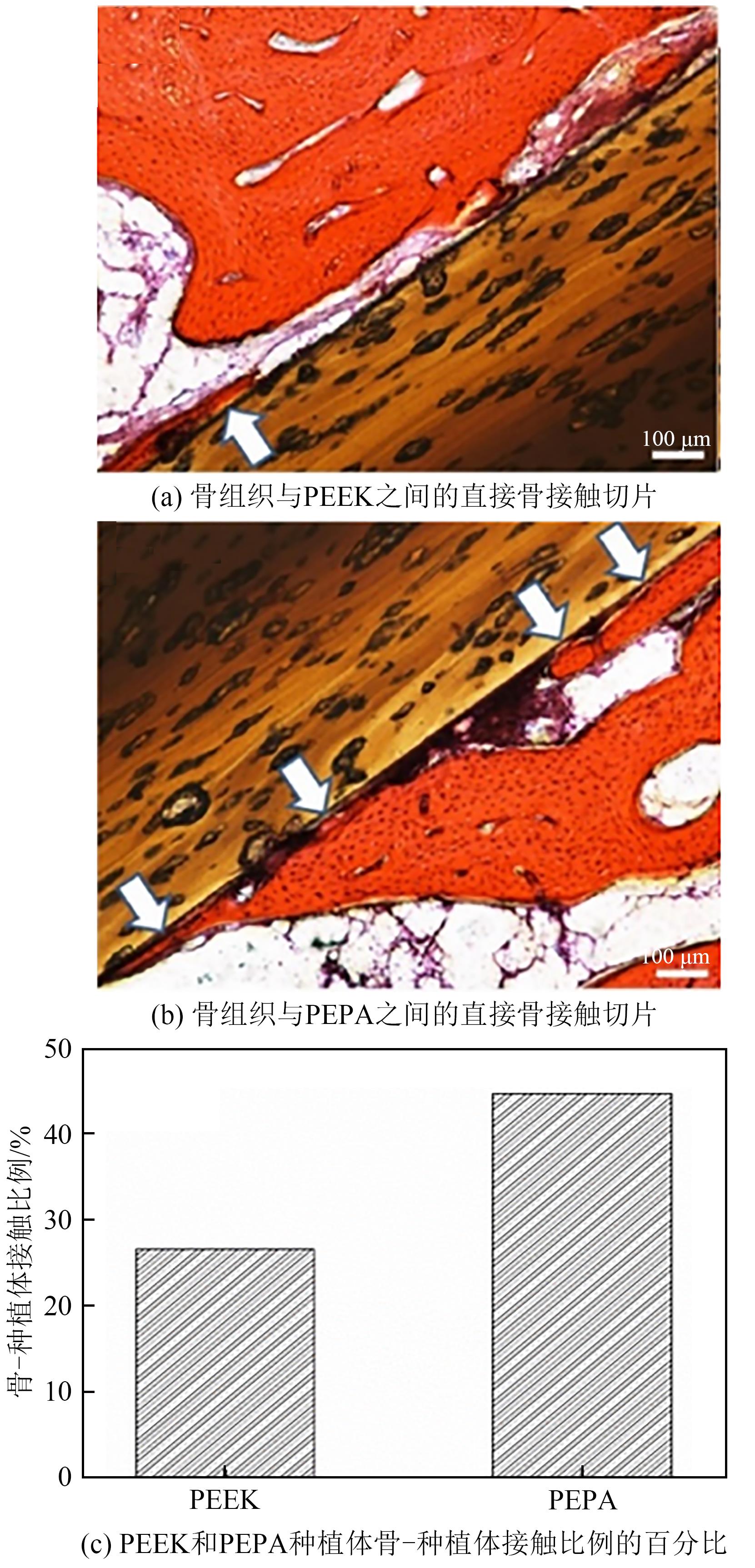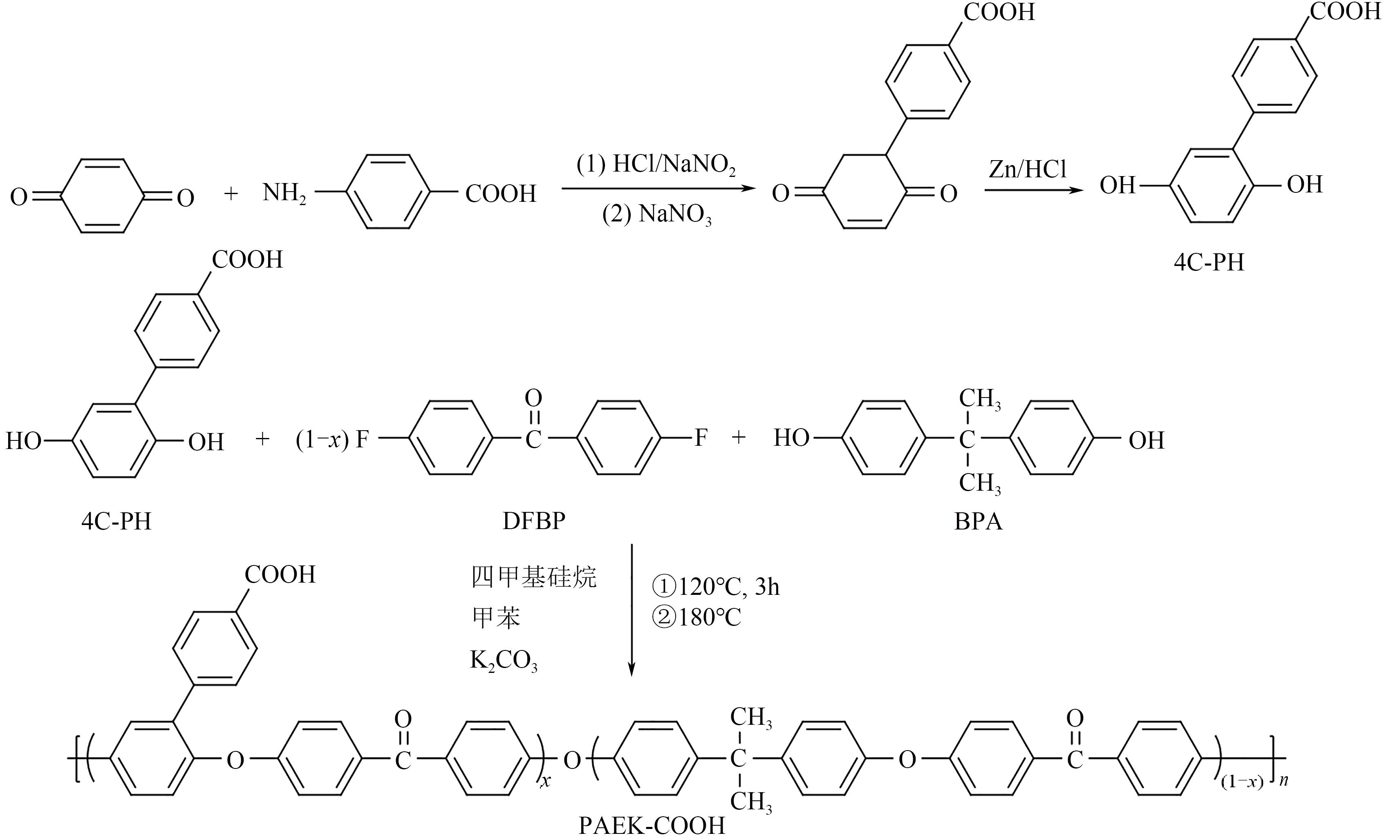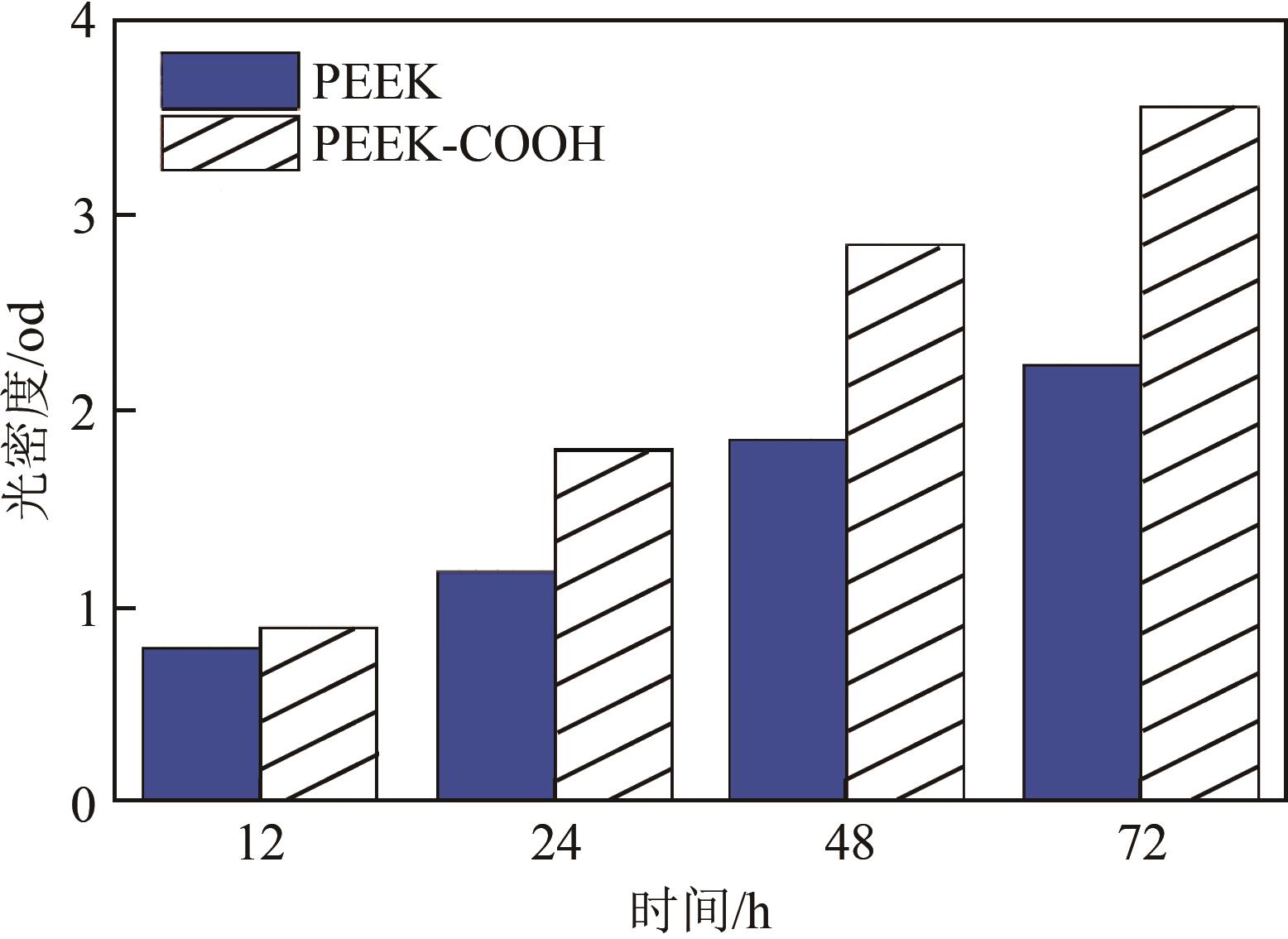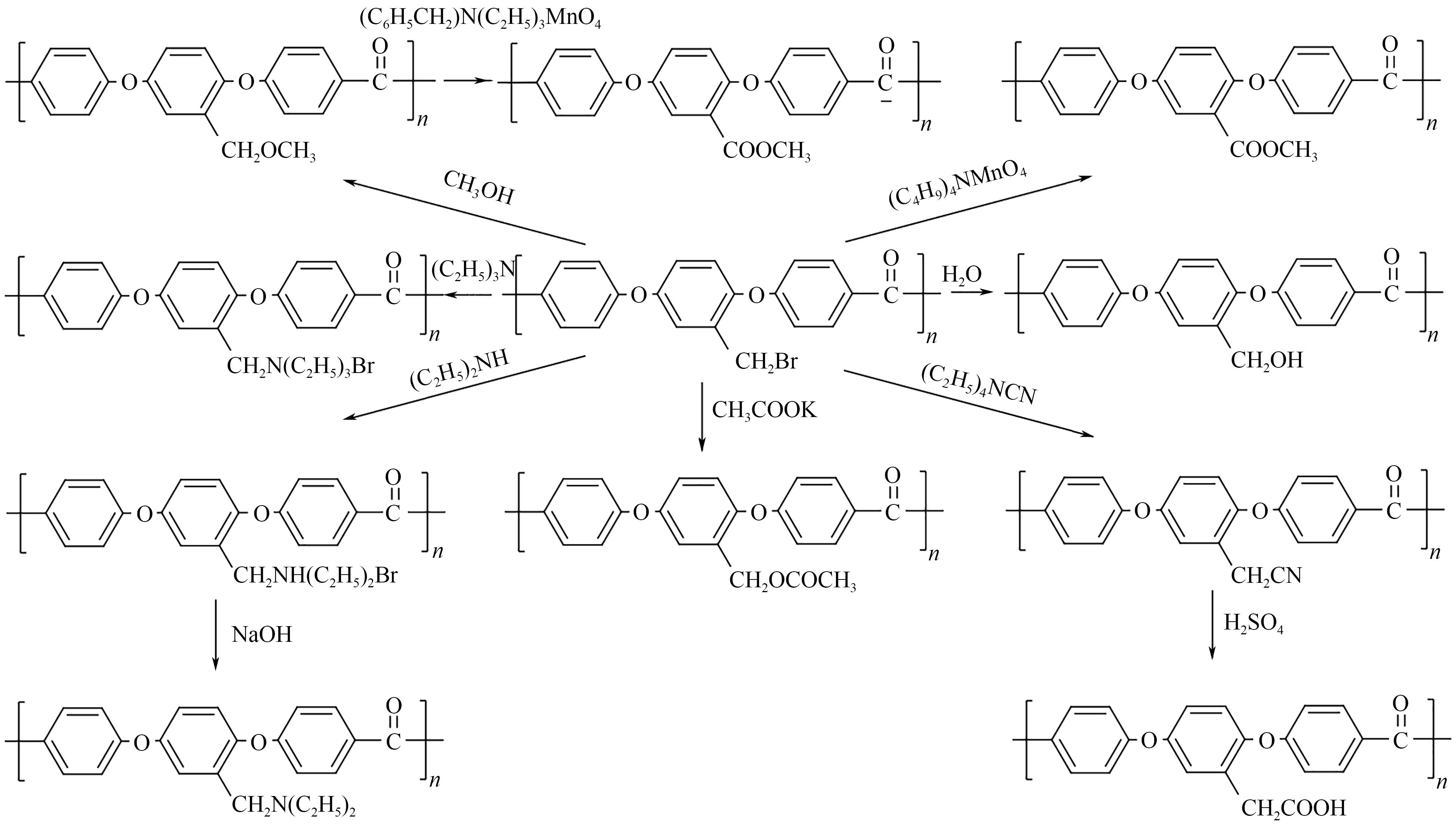化工进展 ›› 2023, Vol. 42 ›› Issue (8): 4015-4028.DOI: 10.16085/j.issn.1000-6613.2023-0500
高生物活性聚醚醚酮化学改性研究进展
陈俊俊1,2( ), 费昌恩1, 段金汤1,2, 顾雪萍1,2, 冯连芳1,2, 张才亮1,2(
), 费昌恩1, 段金汤1,2, 顾雪萍1,2, 冯连芳1,2, 张才亮1,2( )
)
- 1.化学工程联合国家重点实验室,浙江大学化学工程与生物工程学院,浙江 杭州 310027
2.浙江大学衢州研究院,浙江 衢州 324000
-
收稿日期:2023-03-31修回日期:2023-05-27出版日期:2023-08-15发布日期:2023-09-19 -
通讯作者:张才亮 -
作者简介:陈俊俊(1997—),男,硕士研究生,研究方向为聚合物反应工程。E-mail:junjunchen@zju.edu.cn。 -
基金资助:国家重点研发计划(2020YFC1107100);浙江大学衢州研究院科技计划(IZQ2020KJ2005)
Research progress on chemical modification of polyether ether ketone for the high bioactivity
CHEN Junjun1,2( ), FEI Chang’en1, DUAN Jintang1,2, GU Xueping1,2, FENG Lianfang1,2, ZHANG Cailiang1,2(
), FEI Chang’en1, DUAN Jintang1,2, GU Xueping1,2, FENG Lianfang1,2, ZHANG Cailiang1,2( )
)
- 1.State Key Laboratory of Chemical Engineering, College of Chemical and Biological Engineering, Zhejiang University, Hangzhou 310027, Zhejiang, China
2.Institute of Zhejiang University-Quzhou, Quzhou 324000, Zhejiang, China
-
Received:2023-03-31Revised:2023-05-27Online:2023-08-15Published:2023-09-19 -
Contact:ZHANG Cailiang
摘要:
由于聚醚醚酮(PEEK)表面疏水及生物惰性,用作骨科材料难以与周围细胞、骨组织结合。通过化学改性在PEEK分子链中引入具有生物活性的功能化基团是提高其表面细胞黏附、增殖和成骨分化能力最有效的方式。基于功能化基团引入位置的不同,本文将PEEK化学改性分为苯环位改性、酮基位改性和共聚改性等三种,并且重点综述了这些不同化学改性方法的原理和特性及其对PEEK材料生物活性的影响。苯环位改性主要是通过强酸处理引入羧基等官能团,但会残留含硫或含硝化合物,对细胞有一定的毒害作用;酮基位改性是通过胺类、硼氢化钠等试剂与酮基反应,进一步接枝引入功能化基团,但是会破坏PEEK主链上的醚酮比,影响物理性能和热性能。通过亲电、亲核及卤代改性等共聚方式在PEEK侧链引入功能化基团,能保持聚合物主链醚酮比基本不变,同时提升材料生物活性,具有良好的应用前景。在化学改性的基础上,研究多种功能基团的协同作用,进一步引入物理改性,优化面向不同场景的综合性能,是拓宽其在医疗领域应用的发展趋势。
中图分类号:
引用本文
陈俊俊, 费昌恩, 段金汤, 顾雪萍, 冯连芳, 张才亮. 高生物活性聚醚醚酮化学改性研究进展[J]. 化工进展, 2023, 42(8): 4015-4028.
CHEN Junjun, FEI Chang’en, DUAN Jintang, GU Xueping, FENG Lianfang, ZHANG Cailiang. Research progress on chemical modification of polyether ether ketone for the high bioactivity[J]. Chemical Industry and Engineering Progress, 2023, 42(8): 4015-4028.
| 聚合物 | 初始干重/g | 湿重/g | 湿重变化质量分数/% | 干重/g | 干重变化质量分数/% | 天数 |
|---|---|---|---|---|---|---|
| PEEK | 0.132 | 0.142 | +7.6 | 0.136 | +3.0 | 7 |
| 0.151 | +14.4 | 0.139 | +5.3 | 15 | ||
| 0.192 | +45.5 | 0.147 | +11.4 | 30 | ||
| PEEK-COOH | 0.114 | 0.123 | +7.9 | 0.118 | +3.5 | 7 |
| 0.132 | +15.8 | 0.121 | +6.1 | 15 | ||
| 0.167 | +46.5 | 0.129 | +13.2 | 30 | ||
| HOOC-PEEK-NH2 | 0.086 | 0.093 | +8.2 | 0.089 | +3.5 | 7 |
| 0.100 | +16.3 | 0.092 | +7.0 | 15 | ||
| 0.126 | +46.5 | 0.098 | +14.0 | 30 |
表1 PEEK、PEEK-COOH和HOOC-PEEK-NH2和模拟体液进行脱细胞体外试验7天、15天和30天的结果[31]
| 聚合物 | 初始干重/g | 湿重/g | 湿重变化质量分数/% | 干重/g | 干重变化质量分数/% | 天数 |
|---|---|---|---|---|---|---|
| PEEK | 0.132 | 0.142 | +7.6 | 0.136 | +3.0 | 7 |
| 0.151 | +14.4 | 0.139 | +5.3 | 15 | ||
| 0.192 | +45.5 | 0.147 | +11.4 | 30 | ||
| PEEK-COOH | 0.114 | 0.123 | +7.9 | 0.118 | +3.5 | 7 |
| 0.132 | +15.8 | 0.121 | +6.1 | 15 | ||
| 0.167 | +46.5 | 0.129 | +13.2 | 30 | ||
| HOOC-PEEK-NH2 | 0.086 | 0.093 | +8.2 | 0.089 | +3.5 | 7 |
| 0.100 | +16.3 | 0.092 | +7.0 | 15 | ||
| 0.126 | +46.5 | 0.098 | +14.0 | 30 |
| 1 | IVAN Vladislavov Panayotov, Orti VALÉRIE, Cuisinier FRÉDÉRIC, et al. Polyetheretherketone (PEEK) for medical applications[J]. Journal of Materials Science: Materials in Medicine, 2016, 27(7): 118. |
| 2 | JONES D P, LEACH D C, MOORE D R. Mechanical properties of poly(ether-ether-ketone) for engineering applications[J]. Polymer, 1985, 26(9): 1385-1393. |
| 3 | 田爱国, 郭强. 聚醚醚酮及其复合材料的特性与应用研究进展[J]. 工程塑料应用, 2002, 30(2): 47-49. |
| TIAN Aiguo, GUO Qiang. Progress in the characteristics and application research of polyetheretherketone and its composites[J]. Engineering Plastics Application, 2002, 30(2): 47-49. | |
| 4 | MA Tongtong, ZHANG Jiajia, SUN Shuoyao, et al. Current treatment methods to improve the bioactivity and bonding strength of PEEK for dental application: A systematic review[J]. European Polymer Journal, 2023, 183: 111757. |
| 5 | HE Miaomiao, HUANG Yong, XU Huan, et al. Modification of polyetheretherketone implants: From enhancing bone integration to enabling multi-modal therapeutics[J]. Acta Biomaterialia, 2021, 129: 18-32. |
| 6 | LEE Woo-Taek, KOAK Jai-Young, Young-Jun LIM, et al. Stress shielding and fatigue limits of poly-ether-ether-ketone dental implants[J]. Journal of Biomedical Materials Research. Part B, Applied Biomaterials, 2012, 100(4): 1044-1052. |
| 7 | DAVOOD Almasi, NIDA Iqbal, MALIHEH Sadeghi, et al. Preparation methods for improving PEEK’s bioactivity for orthopedic and dental application: A review[J]. International Journal of Biomaterials, 2016, 2016: 8202653. |
| 8 | DONDANI Jay R, JANAKI Iyer, TRAN Simon D. Surface treatments of PEEK for osseointegration to bone[J]. Biomolecules, 2023, 13(3): 464. |
| 9 | 张少甫, 胡凡琦, 杨晓清, 等. PEEK融合器在强直性脊柱炎胸腰段后凸畸形合并Andersson骨折手术中的应用[J]. 解放军医学院学报, 2018, 39(5): 400-404. |
| ZHANG Shaofu, HU Fanqi, YANG Xiaoqing, et al. PEEK cage for treatment of thoracolumbar kyphosis deformity in ankylosing spondylitis patients with andersson fracture[J]. Academic Journal of Chinese PLA Medical School, 2018, 39(5): 400-404. | |
| 10 | GAO Chengzhe, WANG Zongliang, JIAO Zixue, et al. Enhancing antibacterial capability and osseointegration of polyetheretherketone (PEEK) implants by dual-functional surface modification[J]. Materials & Design, 2021, 205: 109733. |
| 11 | 刘湲秋, 汪清漩, 陆懿琳, 等. 聚醚醚酮涂层制备、改性及应用的研究综述[J]. 塑料工业, 2020, 48(10): 1-7. |
| LIU Yuanqiu, WANG Qingxuan, LU Yilin, et al. A review of the preparation, modification and application of PEEK coating[J]. China Plastics Industry, 2020, 48(10): 1-7. | |
| 12 | RIVEIRO A, SOTO R, COMESAÑA R, et al. Laser surface modification of PEEK[J]. Applied Surface Science, 2012, 258(23): 9437-9442. |
| 13 | KAWANO Tessei, WANG Meng-Jiy, ANDOU Yoshito. Surface modification of a regenerated cellulose film using low-pressure plasma treatment with various reactive gases[J]. ACS Omega, 2022, 7(48): 44085-44092. |
| 14 | 肖天华, 刘荣涛, 庞贻宇, 等. 骨植入聚醚醚酮材料表面改性的研究进展[J]. 广东工业大学学报, 2021, 38(2): 73-82. |
| XIAO Tianhua, LIU Rongtao, PANG Yiyu, et al. Progress on bone graft PEEK about surface modification[J]. Journal of Guangdong University of Technology, 2021, 38(2): 73-82. | |
| 15 | SUGANO Kiriko, KOMADA Wataru, OKADA Daizo, et al. Evaluation of composite resin core with prefabricated polyetheretherketone post on fracture resistance in the case of flared root canals[J]. Dental Materials Journal, 2020, 39(6): 924-932. |
| 16 | 刘吕花, 张伟芳, 郑延延. 磺酸基修饰聚醚醚酮表面及其成骨活性[J]. 工程塑料应用, 2021, 49(11): 14-20. |
| LIU Lyuhua, ZHANG Weifang, ZHENG Yanyan. Sulfonate group-tailored polyetheretherketone surface and its osteogenic activity[J]. Engineering Plastics Application, 2021, 49(11): 14-20. | |
| 17 | DAOUST D, DEVAUX J, GODARD P. Part 1. Qualitative comparison between polymer and monomer model compound sulfonation[J]. Polymer International, 2001, 50(8): 917-924. |
| 18 | HUANG R Y M, SHAO P H, BURNS C M, et al. Sulfonation of poly(ether ether ketone)(PEEK): Kinetic study and characterization[J]. Journal of Applied Polymer Science, 2001, 82(11): 2651-2660. |
| 19 | 魏浩然, 黄振圣, 程伟, 等. 磺化聚醚醚酮的合成工艺优化及表征[J]. 武汉纺织大学学报, 2013, 26(3): 68-71. |
| WEI Haoran, HUANG Zhensheng, CHENG Wei, et al. Characterization and synthesis process optimization of sulfonated poly(ether ether ketone)[J]. Journal of Wuhan Textile University, 2013, 26(3): 68-71. | |
| 20 | MENG Ziqiang, LIU Yuxiang, WU Dongmei. Effect of sulfur dioxide inhalation on cytokine levels in lungs and serum of mice[J]. Inhalation Toxicology, 2005, 17(6): 303-307. |
| 21 | MENG Ziqiang, QIN Guohua, ZHANG Bo, et al. DNA damaging effects of sulfur dioxide derivatives in cells from various organs of mice[J]. Mutagenesis, 2004, 19(6): 465-468. |
| 22 | OUYANG Liping, ZHAO Yaochao, JIN Guodong, et al. Influence of sulfur content on bone formation and antibacterial ability of sulfonated PEEK[J]. Biomaterials, 2016, 83: 115-126. |
| 23 | WAN Teng, JIAO Zixue, GUO Min, et al. Gaseous sulfur trioxide induced controllable sulfonation promoting biomineralization and osseointegration of polyetheretherketone implants[J]. Bioactive Materials, 2020, 5(4): 1004-1017. |
| 24 | SAGMEISTER Peter, POMS Johannes, WILLIAMS Jason D, et al. Multivariate analysis of inline benchtop NMR data enables rapid optimization of a complex nitration in flow[J]. Reaction Chemistry & Engineering, 2020, 5(4): 677-684. |
| 25 | CONCEIÇÃO Thiago F, BERTOLINO José R, BARRA Guilherme M O, et al. Preparation and characterization of poly(ether ether ketone) derivatives[J]. Journal of the Brazilian Chemical Society, 2008, 19(1): 111-116. |
| 26 | MA Jing, LIANG Qian, QIN Wen, et al. Bioactivity of nitric acid and calcium chloride treated carbon-fibers reinforced polyetheretherketone for dental implant[J]. Journal of the Mechanical Behavior of Biomedical Materials, 2020, 102: 103497. |
| 27 | LI Yanhua, WANG Jing, HE Dong, et al. Surface sulfonation and nitrification enhance the biological activity and osteogenesis of polyetheretherketone by forming an irregular nano-porous monolayer[J]. Journal of Materials Science: Materials in Medicine, 2019, 31(1): 1-12. |
| 28 | DING Rui, CHEN Taijun, XU Qizhen, et al. Mixed modification of the surface microstructure and chemical state of polyetheretherketone to improve its antimicrobial activity, hydrophilicity, cell adhesion, and bone integration[J]. ACS Biomaterials Science & Engineering, 2020, 6(2): 842-851. |
| 29 | HUO Shicheng, MENG Xiangchao, ZHANG Shutao, et al. Hydrofluoric acid and nitric acid cotreatment for biofunctionalization of polyetheretherketone in M2 macrophage polarization and osteogenesis[J]. Journal of Biomedical Materials Research Part A, 2021, 109(6): 879-892. |
| 30 | CHEN Meiling, OUYANG Liping, LU Tao, et al. Enhanced bioactivity and bacteriostasis of surface fluorinated polyetheretherketone[J]. ACS Applied Materials & Interfaces, 2017, 9(20): 16824-16833. |
| 31 | PRAMANIK Sumit, KAR Kamal K. Functionalized poly(ether ether ketone): Improved mechanical property and acellular bioactivity[J]. Journal of Applied Polymer Science, 2012, 123(2): 1100-1111. |
| 32 | FRANCHINA Nicole L, MCCARTHY Thomas J. Surface modifications of poly(ether ether ketone)[J]. Macromolecules, 1991, 24(11): 3045-3049. |
| 33 | MANOLAKIS Ioannis, CROSS Paul, COLQUHOUN Howard M. Direct iminization of PEEK[J]. Macromolecules, 2011, 44(19): 7864-7867. |
| 34 | NOISET Olivier, HENNEUSE Catherine, SCHNEIDER Yves-Jacques, et al. Surface reduction of poly(aryl ether ether ketone) film: UV spectrophotometric, 3H radiochemical, and X-ray photoelectron spectroscopic assays of the hydroxyl functions[J]. Macromolecules, 1997, 30(3): 540-548. |
| 35 | ZHENG Yanyan, XIONG Chengdong, WANG Zhecun, et al. Enhanced osteoblast cells adhesion, spreading, and proliferation to surface-carboxylated poly(etheretherketone)[J]. Journal of Bioactive and Compatible Polymers, 2015, 30(3): 302-318. |
| 36 | María Díez-Pascual ANA, GERARDO Martínez, JOSÉ Miguel González-Domínguez, et al. Grafting of a hydroxylated poly(ether ether ketone) to the surface of single-walled carbon nanotubes[J]. Journal of Materials Chemistry, 2010, 20(38): 8285-8296. |
| 37 | KYOMOTO PHD Masayuki, MORO MD PHD Toru, YAMANE MSC Shihori, et al. Smart PEEK modified by self-initiated surface graft polymerization for orthopedic bearings[J]. Reconstructive Review, 2014, 4(3): 36-45. |
| 38 | ZHENG Yanyan, LIU Lyuhua, XIAO Li, et al. Enhanced osteogenic activity of phosphorylated polyetheretherketone via surface-initiated grafting polymerization of vinylphosphonic acid[J]. Colloids and Surfaces B: Biointerfaces, 2019, 173: 591-598. |
| 39 | LONG Timothy M, PRAKASH Shaurya, SHANNON Mark A, et al. Water-vapor plasma-based surface activation for trichlorosilane modification of PMMA[J]. Langmuir, 2006, 22(9): 4104-4109. |
| 40 | ZHENG Yanyan, XIONG Chengdong, ZHANG Shenglan, et al. Bone-like apatite coating on functionalized poly(etheretherketone) surface via tailored silanization layers technique[J]. Materials Science and Engineering C, 2015, 55: 512-523. |
| 41 | ZHENG Yanyan, LIU Lvhua, XIONG Chengdong, et al. Enhancement of bioactivity on modified polyetheretherketone surfaces with —COOH, —OH and —PO4H2 functional groups[J]. Materials Letters, 2018, 213: 84-87. |
| 42 | 刘勇军. 聚芳醚酮的合成与改性研究[D]. 南昌: 江西师范大学, 2005. |
| LIU Yongjun. Study on synthesis and properties of polyaromatic ether ketone[D]. Nanchang: Jiangxi Normal University, 2005. | |
| 43 | ZOLOTUKHIN Mikhail G, COLQUHOUN Howard M, SESTIAA Lionel G, et al. One-pot synthesis and characterization of soluble poly(aryl ether-ketone)s having pendant carboxyl groups[J]. Macromolecules, 2003, 36(13): 4766-4771. |
| 44 | HUNTER Robert A, TURNER Peter D, STEPHEN Rimmer. Suspension cross-linking of poly(aryl ether ketone)s containing carboxylic acid functionality[J]. Journal of Materials Chemistry, 2001, 11(3): 736-740. |
| 45 | 任雯清. 聚醚醚酮(PEEK)合成研究[D]. 上海: 复旦大学, 2011. |
| REN Wenqing. The synthesis and property investigation of polyetheretherketone[D]. Shanghai: Fudan University, 2011. | |
| 46 | 申洪城. 基于含羧基聚芳醚酮超滤膜的制备及性能研究[D]. 长春: 长春工业大学, 2021. |
| SHEN Hongcheng. Preparation and properties of ultrafiltration membrane based on poly(aryl ether ketone) with carboxyl groups[D]. Changchun: Changchun University of Technology, 2021. | |
| 47 | 陆学庆, 王锡铭. 一种含有羧基侧基的聚芳醚酮类树脂及其合成方法: CN113999386A[P]. 2023-06-06. |
| LU Xueqing, WANG Ximing. Polyaryletherketone resin containing side carboxyl group and synthesis method thereof: CN113999386A[P]. 2023-06-06. | |
| 48 | MOULAY Saad. Towards halomethylated benzene-bearing monomeric and polymeric substrates[J]. Designed Monomers and Polymers, 2011, 14(3): 179-220. |
| 49 | 张润鑫, 李俊源, 冯莺, 等. 苯乙烯氯化原位接枝改性氯化聚氯乙烯的研究[J]. 弹性体, 2006, 16(5): 1-5. |
| ZHANG Runxin, LI Junyuan, FENG Ying, et al. Synthesis of styrene grafting modified CPVC using in situ chlorinated graft method[J]. China Elastomerics, 2006, 16(5): 1-5. | |
| 50 | RAO V L, SABEENA P U, SAXENA A, et al. Synthesis and properties of poly(aryl ether ether ketone) copolymers with pendant methyl groups[J]. European Polymer Journal, 2004, 40(11): 2645-2651. |
| 51 | WANG Fei, ROOVERS Jacques, TOPOROWSKI Paul M. Synthesis and molecular characterization of narrow molecular weight distribution fractions of methyl-substituted poly(aryl ether ether ketone)[J]. Macromolecules, 1993, 26(15): 3826-3832. |
| 52 | HENDRIX Katrien, VANEYNDE Marianne, KOECKELBERGHS Guy, et al. Synthesis of modified poly(ether ether ketone) polymer for the preparation of ultrafiltration and nanofiltration membranes via phase inversion[J]. Journal of Membrane Science, 2013, 447: 96-106. |
| 53 | WANG Fei, ROOVERS Jacques. Functionalization of poly(aryl ether ether ketone) (PEEK): Synthesis and properties of aldehyde and carboxylic acid substituted PEEK[J]. Macromolecules, 1993, 26(20): 5295-5302. |
| 54 | WANG Fei, ROOVERS Jacques. Functionalization of poly(aryl ether ether ketone): Synthesis of bromomethylated PEEK and its functionalization[J]. Journal of Polymer Science Part A: Polymer Chemistry, 1994, 32(13): 2413-2424. |
| [1] | 陈明星, 王新亚, 张威, 肖长发. 纤维基耐高温空气过滤材料研究进展[J]. 化工进展, 2023, 42(5): 2439-2453. |
| [2] | 杨凯璐, 陈明星, 王新亚, 张威, 肖长发. 染料废水处理用纳滤膜制备及改性研究进展[J]. 化工进展, 2023, 42(10): 5470-5486. |
| [3] | 田帅, 朱易春, 黄书昌, 连军锋, 秦欣欣, 任黎晔, 李鑫. 厌氧生物处理低浓度污水研究进展[J]. 化工进展, 2021, 40(4): 2338-2346. |
| [4] | 高文伟,孙丽莹,张泽天,谢陶玲,王俊超,李正军. 生物质基含硅骨修复复合支架材料的制备、特性及评价[J]. 化工进展, 2019, 38(10): 4595-4605. |
| [5] | 覃发梅, 邱学青, 孙川, 丁子先, 方志强. 纳米纤维素去除水体系重金属离子的研究进展[J]. 化工进展, 2019, 38(07): 3390-3401. |
| [6] | 赵珮妮, 和法涛, 宋烨, 吴茂玉, 葛邦国, 刘光鹏. 白果的特异生物活性和药理作用研究进展[J]. 化工进展, 2017, 36(S1): 366-371. |
| [7] | 孙媛媛, 屈树国, 李建隆. 质子交换膜燃料电池用磺化聚醚醚酮膜的研究进展[J]. 化工进展, 2016, 35(09): 2850-2860. |
| [8] | 罗成成, 王晖, 陈勇. 纤维素的改性及应用研究进展[J]. 化工进展, 2015, 34(3): 767-773. |
| [9] | 蒋永荣,刘成良,刘可慧,韦平英 . 硫酸盐有机废水厌氧处理颗粒污泥研究进展[J]. 化工进展, 2014, 33(09): 2463-2470. |
| [10] | 农韦健1,陈小鹏2,梁杰珍2,王琳琳2,黄科林1,史磊3,吴睿1,李克贤1 . 枞酸单离与应用研究进展[J]. 化工进展, 2014, 33(05): 1259-1264. |
| [11] | 韩 玲,张淑平,刘晓慧. 海藻生物活性物质应用研究进展[J]. 化工进展, 2012, 31(08): 1794-1800. |
| [12] | 冯爱玲,憨 勇. 生物医用镁的表面处理技术研究进展 [J]. 化工进展, 2011, 30(8): 1778-. |
| [13] | 王万林1,王海滨2,霍冀川1,雷永林1,吕淑珍1. 木质素磺酸盐减水剂改性研究进展 [J]. 化工进展, 2011, 30(5): 1039-. |
| [14] | 张 智 峰. 纤维素改性研究进展 [J]. 化工进展, 2010, 29(8): 1493-. |
| [15] | 王小蓉,郝广平,李文翠. 生物活性炭技术在水处理中的研究与应用 [J]. 化工进展, 2010, 29(5): 932-. |
| 阅读次数 | ||||||
|
全文 |
|
|||||
|
摘要 |
|
|||||


